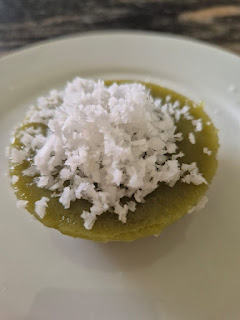As we know an omelette is a dish made from eggs. The fillings that can be included are up to our imagination - chives, potato long beans, spinach, onion, prawns, etc. One day I ran out of idea of what to cook and finding a piece of tofu in my refrigerator I decided to try making tofu omelette. It turned out to be so delicious that I have cooked it a couple of times, the first time with just chilli padi and the second with coriander and chilli padi. I will try to add other fillings later.
Ingredients:
- 1 piece of tofu
- 1 egg
- 1 piece chilli padi
- 1 small sprig coriander or green onion (only green part)
- 1/4 tsp salt
- 1 tbsp light soy sauce
- 1/2 tsp pepper
- 3 tbsp cooking oil
Instruction:
- Half the tofu horizontally and slice the tofu into 4 mm thickness or just slice the tofu into 4 mm thickness. Set aside.
- Cut the chilli padi into small pieces and roughly mince them.
- Cut the coriander and mince it. (Or, cut the green onion into small pieces.)
- Crack the egg into a bowl and beat it with the salt, soy sauce and pepper.
- Add the chilli padi and coriander (or green onion).
- Add the tofu to the bowl of egg and coat all pieces with the beaten egg.
- Heat up a frying pan with cooking oil.
- Use a spoon to scoop the tofu, piece by piece, into the pan. Arrange the tofu anyhow you like.
- When the bottom is cooked, turn over the omelette and cook the other side.
- Once the omelette is done, slide it from the pan to a serving plate.
- You may decorate it with some coriander or green onion on top of the omelette.





































